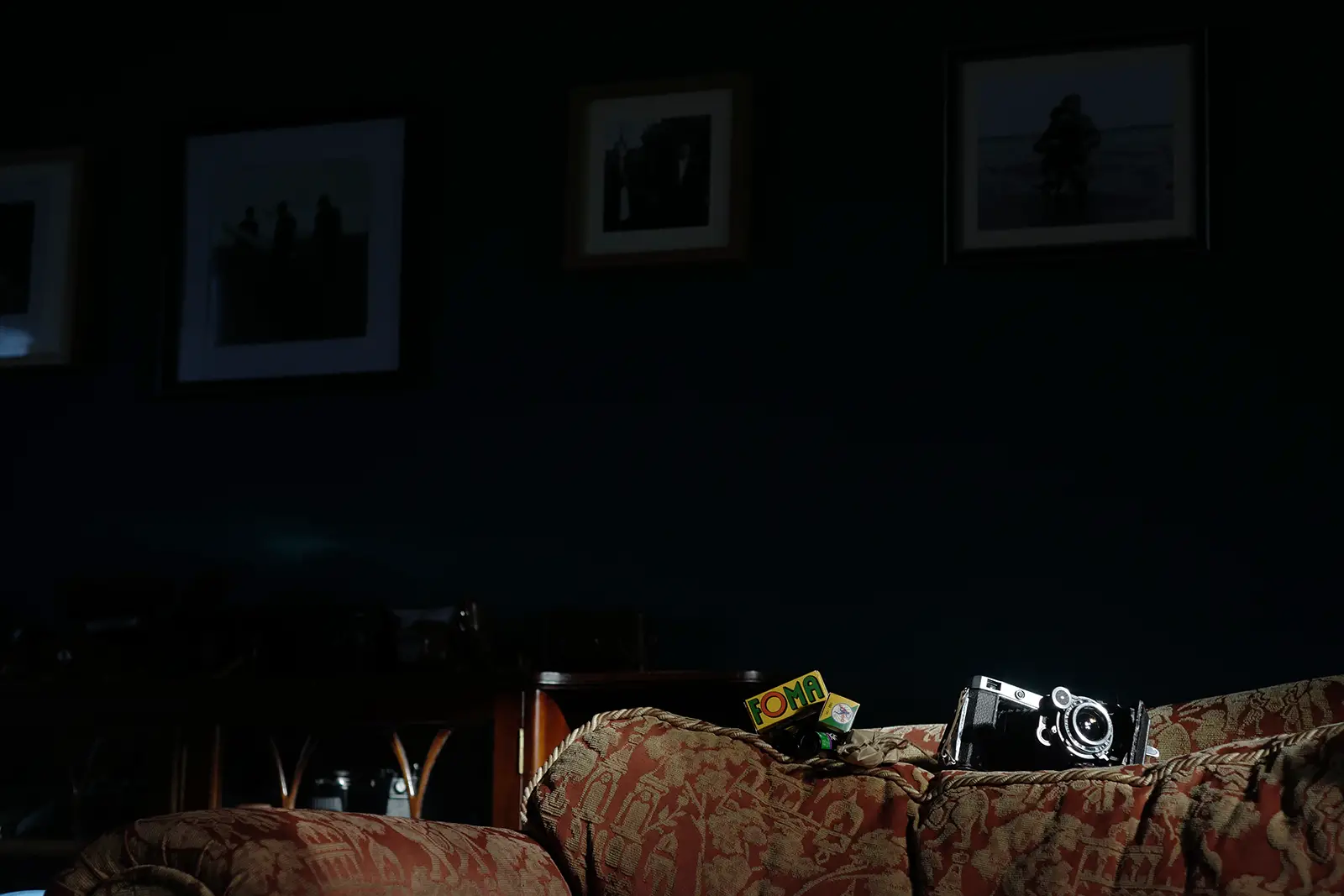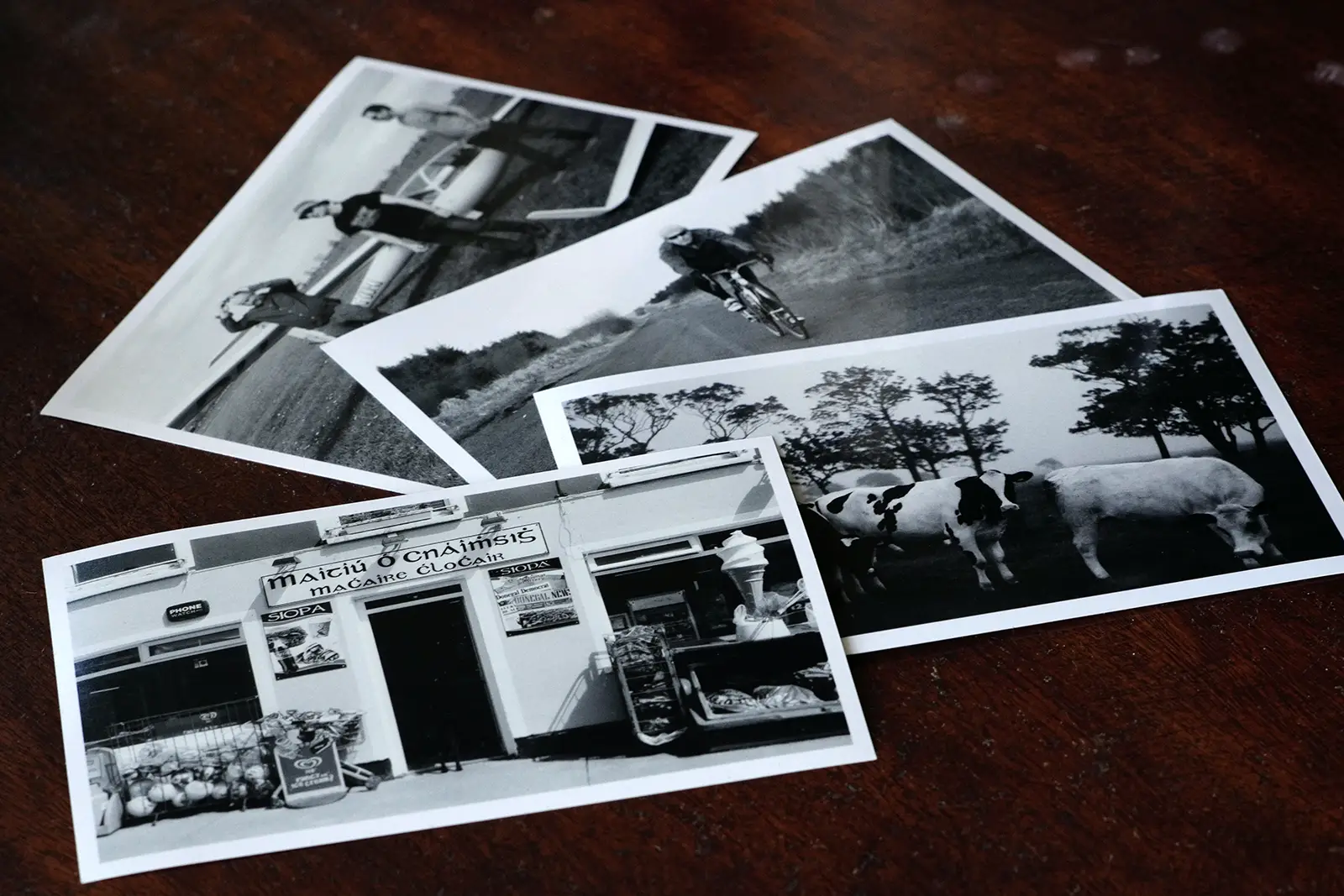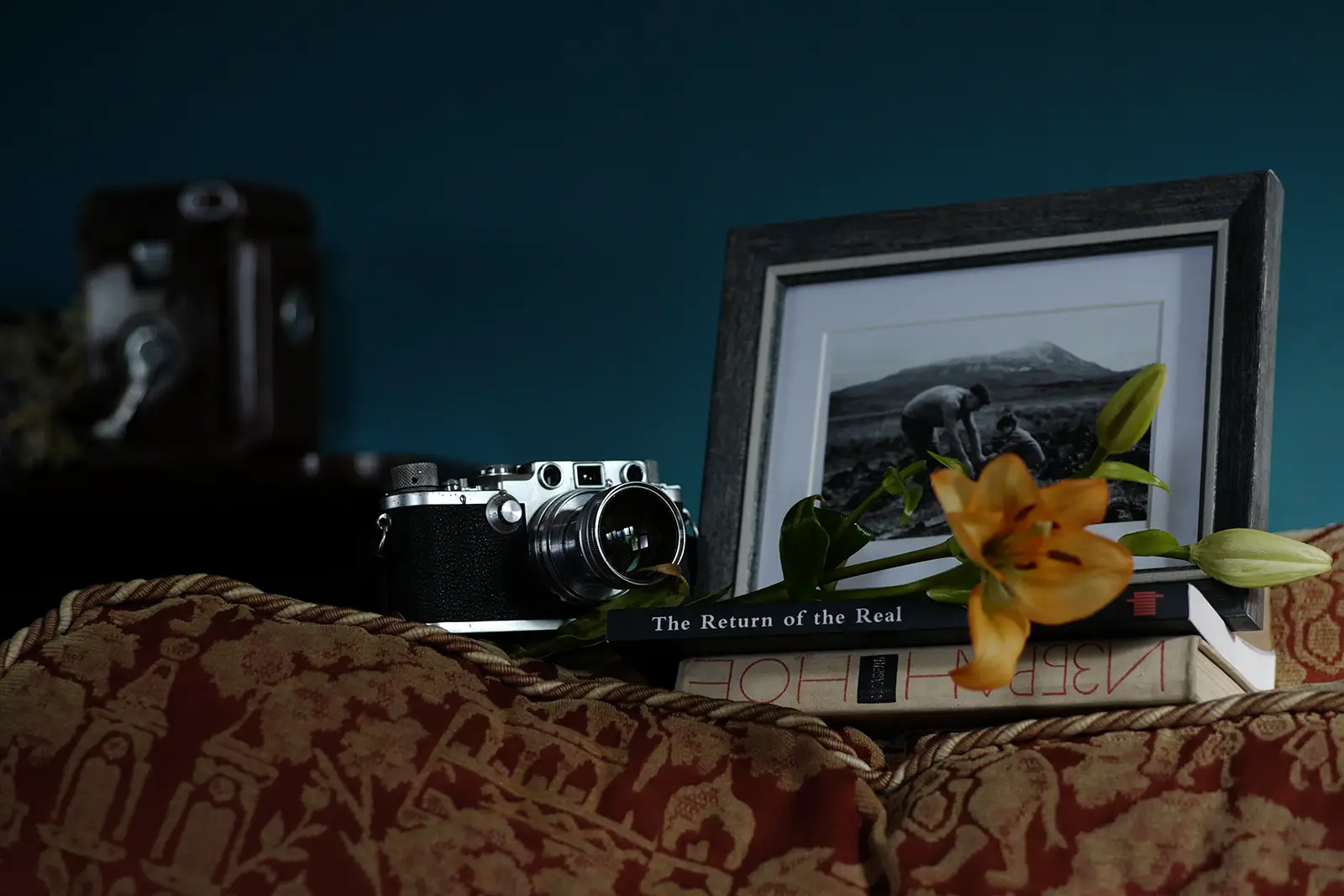Last week I received a message from someone who happened upon my website. They had read that I shoot both digital and film, but could only find examples of digital photos. Where could they view some of my analogue work? And I realised then: They couldn’t.
Well, technically they could – by visiting my house. Our walls are covered with framed darkroom prints. Albums and boxes full of prints and negatives are stacked upon shelves and hidden under beds. But I haven’t digitised film in years. After I shoot a roll of film, it gets developed, then photographically printed. No digital steps are involved and the print is the final result. I do sometimes take digital photos that depict prints or negatives as objects. But I don’t digitise the photographic images.
I cannot say for certain why my process has become what it has. I am not a purist and do not espouse a philosophy of keeping things 100% analogue. I have nothing against scanning, or against digitally storing, viewing and sharing, or even against digitally editing, shots taken with film. I used to do all of those things. Then I stopped.
It happened unconsciously and gradually. To begin with, my workflow was in line with what others describe: I would shoot a roll of film, then either develop it, ask my husband to develop it, or send it out to a lab {I do all of the above, depending on available time, life circumstances, etc. – I told you I am not a purist!}. I would then scan the negatives. And upon reviewing, and sometimes tweaking the digitised images using photo editing software, I would decide which to print, which to keep and perhaps share, and which to discard.
The first part of the process to go was the default batch scanning. Most likely this was simply because I grew tired of spending so much time at my computer, and headachy from the constant noise of the scanner {its lamentful churnings had become the soundtrack to my daily existence!} Yet I could not afford to pay for digitising services considering the volume of my output, so scanning myself was the only viable option. Eventually it occurred to me: Why bother going through the time-consuming process of scanning entire rolls of film, when in the end only certain frames from each roll were worthwhile? So instead of batch-scanning, I began using a light table to review the negatives. I would then only scan those negatives which looked promising. Sometimes the darkroom print would even happen before the scan, if a negative looked especially exciting.
This newfound workflow suited me for a while. My scanning time was greatly reduced, and I was re-gaining my ‘eye’ for evaluating images in their negative form, which I was quite enjoying.
If I have to pinpoint a specific incident that took things to the next level, it was this: I had taken a particularly successful black and white photo with my trusty Rolleiflex. The darkroom print was so lovely, I couldn’t put it down – it looked as if the image had been poured onto the paper in liquid silver. After gazing at my gorgeous print ecstatically for what seemed like hours, I hurried to scan the negative.
The scan was nice. Yet somehow… unsatisfying? I re-scanned. Then re-scanned again. I messed with the scanner settings. I messed with the image in Photoshop. It remained nice. Had I not seen the darkroom print, I would have been happy with the photo on my screen. Great dynamic range, sharp, interesting composition, a sense of mood and narrative, all the things. Very nice. But nice is not magical. Nice is not tactile. Nice is not… real. I felt compelled to delete the scan. I framed the photo and hung it up on the wall.
At the time I did not experience this as a shift in my thinking. Life went on, and it was only some time later I became aware that I was scanning less and less frequently. One day I was tidying up the room where the scanner was kept and noticed cobwebs. It had been more than two years since I’d last used it. But it was only after receiving that message, asking where my film shots could be viewed, that it truly hit me: I had gone all-analogue, to the extreme.

Reflecting on my process now, I can see that there are both benefits and drawbacks. The biggest benefit, I feel – as cringingly earnest as this sounds – is a sense of creative fulfilment. In retrospect, I realise that displaying and sharing the digitised versions of my film photos, carried an undercurrent of discontent, even if I were not explicitly aware of it. In a way, it felt as if I was dealing with hollow imposter images and not the photos themselves. I am a painter as well as a photographer, and perhaps this bias stems from that. When I first began taking photos {back in the day, when film was the default option}, it was the physicality of photography that attracted me: the feel of the negatives, the smell of the darkroom chemicals, the idea of silver gelatin being used to capture a moment in time and transform it into a fixed object. Returning to that process with all its visceral implications and valuing it as the end-goal {as opposed to an intermediate step in a process that ultimately results in a digital image}, offers me something intangible yet deeply gratifying. As a secondary benefit, keeping things entirely analogue does allow me more time away from my computer, which is something I value more and more these days.
As for the drawbacks, they are fairly obvious. In an era of ‘pictures or it didn’t happen,’ to claim that I shoot film and then have nothing to show for it to the virtual world, feels a bit suspect. And while at this stage in my life I feel like I have nothing to prove, it’s not so much about that as it is about the natural human inclination to share and communicate. Yes, all of my favourite photos are displayed in physical form and they get seen. But not on a scale we are now accustomed to images being seen. And so a part of me wonders: Am I ‘justified’ in taking analogue photos, if their viewership is so pathetically limited?
Editing is another aspect of an all-analogue workflow worth considering. The parameters of my process make it tricky to correct or alter images that are flawed yet sufficiently interesting – or sentimentally valuable – to warrant printing. Neither mine, nor my husband’s darkroom skills are good enough to work magic on problematic negatives. We can compensate for imperfect exposure, and can make basic dodge and burn masks, but we lack the knowledge needed for proper analogue retouching. Importantly, we also lack the time and patience. After all, a fix that would take me seconds to execute on a digitised negative using image editing software, would require hours of darkroom work …for each individual print. I admit that I lack that degree of commitment.

On the logistical side of things, there is also the question of display and storage. What do I do with all the prints? My favourite ones are up on walls. And not just in our house. I gift photos to friends and family. Occasionally I sell some. And while I haven’t attempted to exhibit in years, a few may still be up in galleries and similar settings. The prints that aren’t framed for display are kept in albums and boxes for browsing, and they do get taken out and looked at quite often. The negatives are also stored in boxes, organised in chronological order. At the moment, the quantity of it all – while substantial – is not so out of control as to make storage a problem {in truth, storage of all my digital images presents more of an issue}. But I do recognise that at some point space could potentially run out.
Perhaps the most pressing concern though, is the lack of digital backup. Should my negatives get damaged, the photos will simply vanish – years of creative work and sentimental keepsakes destroyed. But after giving this some thought, I ultimately decided that if that were to happen, the photos would be gone regardless; having digital backups won’t bring them back. It is the physical negatives I feel attached to and it is them I would mourn; I doubt that having their digitised ghosts would console me. Nevertheless, I admit it’s a good idea to digitise at least my favourite photos… perhaps in addition to investing in fireproof, waterproof storage!
In writing this article, my aim was to share my process and to examine how I arrived at it. There are elements of my approach which are admittedly problematic, and so I neither promote it nor encourage others to adapt it. Furthermore, I cannot say that I myself am committed to continuing down the all-analogue path. After years of photographing in a bubble, I would like to be part of a larger dialogue again, to share my film images. For that reason I am considering re-introducing a digital element into my workflow – but in what form exactly, I do not yet know.
But moreover… It is the lack of intentionality, I think, that is making me question my process. It is starting to feel as if my current approach to film is a coping mechanism of sorts, a response to a creative midlife crisis – rather than a result of conviction. So perhaps in writing this, my hope is to recognise that – and overcome it. Thank you for following along.
___
NOTES
The camera pictured in the first image is a Leica IIIf. The camera pictured in the second image is a Moskva 5 {a medium format 6×9 rangefinder}. All illustrative images in this article were taken with a digital Leica CL.
For anyone interested in critical theory: Hal Foster’s The Return of the Real pertains to some of the ideas discussed here.
Ailbíona McLochlainn is a photographer, knitwear designer, and recovering academic, based in Ireland. For additional information and lots of pictures to look at, visit www.ailbiona.com
Share this post:









Comments
Vlkr on All Analogue: a Digital-Free Experience of Film Photography – By Ailbíona McLochlainn
Comment posted: 16/02/2022
Comment posted: 16/02/2022
Martin on All Analogue: a Digital-Free Experience of Film Photography – By Ailbíona McLochlainn
Comment posted: 16/02/2022
I guess it's time for an exhibition or a series of videos like 1000 Masterworks which aired years back on TV.
For the younger ones: That is meant
https://youtu.be/6hcqo7kRhU4
(randomly chosen)
Take care!
Comment posted: 16/02/2022
Donato Rondinelli on All Analogue: a Digital-Free Experience of Film Photography – By Ailbíona McLochlainn
Comment posted: 16/02/2022
Thank you so much for sharing your story. You’re honesty is refreshing. You’ve touched on some important things. Thanks for providing a little direction as a result of your own experiences. Photography can be a very isolating hobby, but stories like yours remind us that it shouldn’t be that way. I feel like this is one of those articles that I can come back to on a regular basis as a self check. Please, continue to document your experiences. Some of us have jumped back into analog mid-life. Stories from experienced people are necessary because time is not on our side. Thank you so much. I look forward to hearing more.
Comment posted: 16/02/2022
BWS on All Analogue: a Digital-Free Experience of Film Photography – By Ailbíona McLochlainn
Comment posted: 16/02/2022
BWS
Comment posted: 16/02/2022
Des McSweeney on All Analogue: a Digital-Free Experience of Film Photography – By Ailbíona McLochlainn
Comment posted: 16/02/2022
Des
Comment posted: 16/02/2022
Martin JONES on All Analogue: a Digital-Free Experience of Film Photography – By Ailbíona McLochlainn
Comment posted: 16/02/2022
Comment posted: 16/02/2022
Merlin Marquardt on All Analogue: a Digital-Free Experience of Film Photography – By Ailbíona McLochlainn
Comment posted: 16/02/2022
Bill Brown on All Analogue: a Digital-Free Experience of Film Photography – By Ailbíona McLochlainn
Comment posted: 17/02/2022
Flash forward to 2006 and my client base had disappeared as PS and digital print output had changed the photography landscape. Everyone was now an artist. Not wanting to become a dinosaur I made the choice to take the leap from the totally analogue process of hand rendered retouching to the computer and PS. I didn't see it as selling out but a way of survival and providing for my family. Now in 2022 I have once again established my place in the local photographic community. My specialties range from large scale high resolution portrait retouching to print restoration, either restoring an original photo or creating a new digital version. The reputation I've built is my analogue approach and thinking that I bring to the process.
I know this is a lengthy reply but I fully believe that analogue is a way of thinking even when using digital processes. I don't disdain digital but have learned to embrace all the possibilities that it brings and at the same time maintain who I am as an analogue thinker and person. It's always beneficial to look beneath the surface and articles such as this create a dialog that can be beneficial on so many levels. Thanks for taking the time to share your story.
Comment posted: 17/02/2022
Comment posted: 17/02/2022
Anton on All Analogue: a Digital-Free Experience of Film Photography – By Ailbíona McLochlainn
Comment posted: 17/02/2022
Comment posted: 17/02/2022
shawn granton on All Analogue: a Digital-Free Experience of Film Photography – By Ailbíona McLochlainn
Comment posted: 17/02/2022
But seeing what things would look like "all analog" has motivated me to do things like occasionally shoot slide film, or get optical prints made. I'm lucky that Blue Moon here in Portland still makes prints the "old" way. I shared some here on 35mc last year, but of course scans of the prints are not the same thing:
https://www.35mmc.com/27/07/2021/minolta-hi-matic-7s-and-a-sentimental-journey-discovering-true-optical-prints-by-shawn-granton/
Anton on All Analogue: a Digital-Free Experience of Film Photography – By Ailbíona McLochlainn
Comment posted: 18/02/2022
Sam Gustafson on All Analogue: a Digital-Free Experience of Film Photography – By Ailbíona McLochlainn
Comment posted: 21/03/2022
When I used to knit, I didn't do it because I wanted a sweater. If I wanted a sweater, I would go to the store and buy one. It's cheaper, faster, and the outcome is more certain. Knitting a sweater is a terrible way to get a sweater. But it's a very satisfying and enjoyable activity.
I approach film photography in the same way. If I just want some pictures of my kids doing whatever they are doing that day, I'll get out my digital camera. I like using it and really love the images it can make. But if I want to enjoy a truly unique photographic experience, to think about light and exposure and focus. To futz and fiddle. To occupy my mind with something challenging but ultimately unimportant (like most hobbies), I will get out my film camera or go down to the darkroom and make some prints. They are two related activities but with fundamentally different purposes.
Comment posted: 21/03/2022